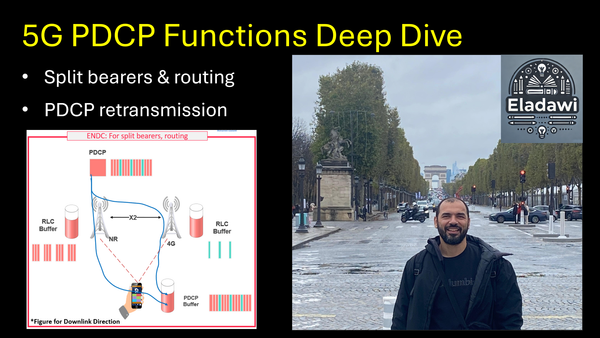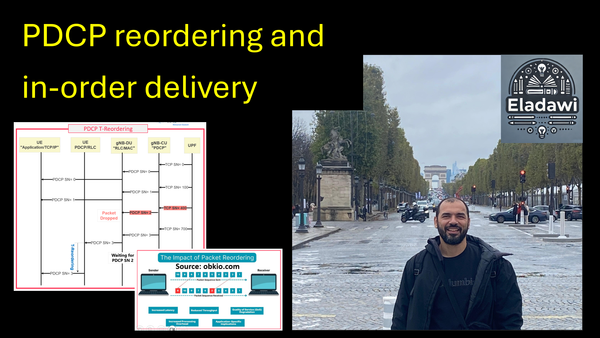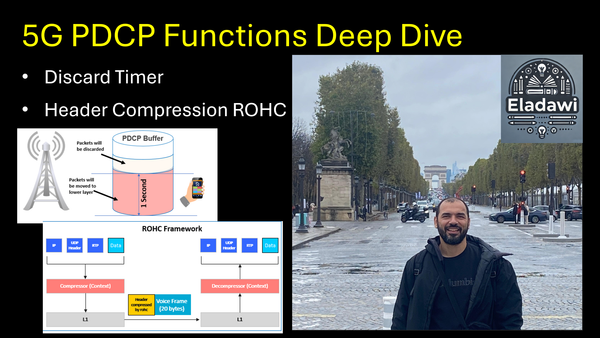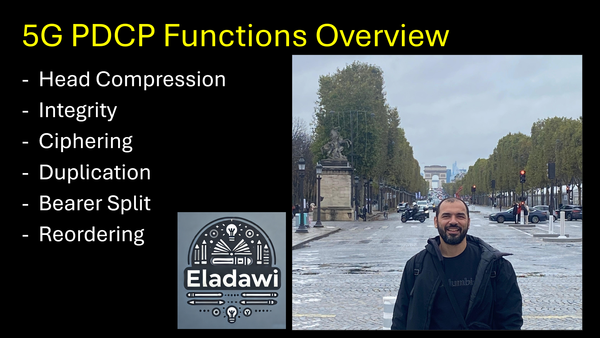Learn about 4G&5G QoS Parameters- Article
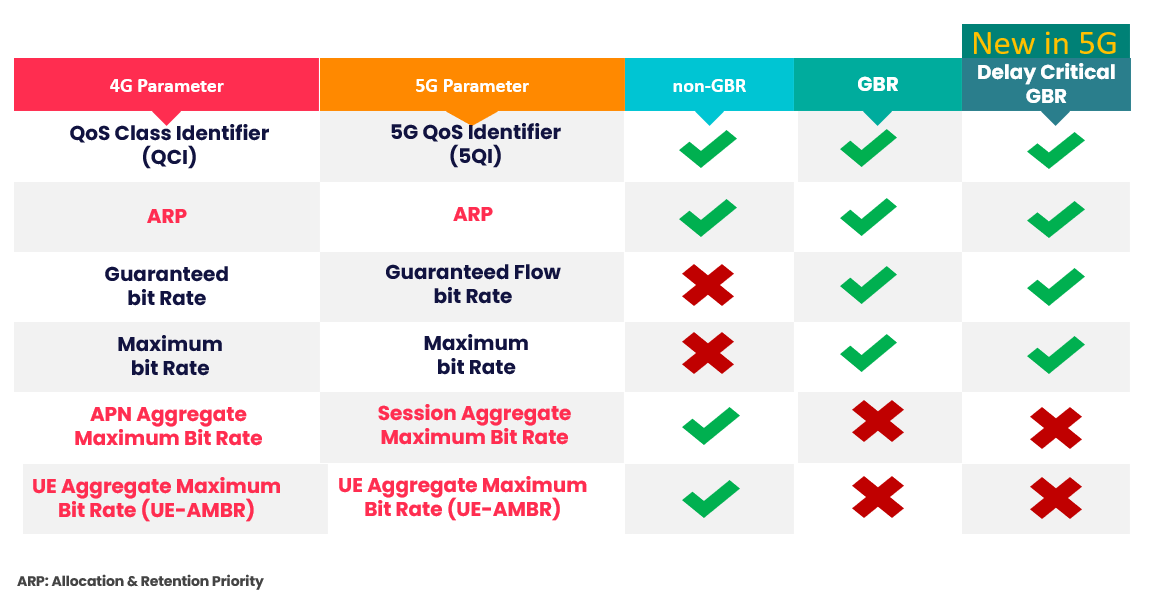
Content:
This Article will help to solidify the basic understanding of 4G & 5G Basic QoS Parameters and related UE Identities. The following is covered in this Article:
- Introduction about QoS
- QoS Parameters Explanation
- 4G QoS Class Identifier (QCI) and 5G QoS Identifier (5QI)
- 4G & 5G ARP (Allocation & Retention Priority )
- 4G Guaranteed bit Rate and 5G Guaranteed Flow bit Rate
- 4G Guaranteed bit Rate and 5G Guaranteed Flow bit Rate
- 4G & 5G QoS Parameters (UE AMBR Vs. APN AMBR)
- How to check QoS Parameters from DT Logs
(1) Introduction about QoS
- Handling different quality-of-service (QoS) requirements is already possible in LTE, and NR builds upon and enhances this framework.
- The key principles of LTE are kept, namely that the network is in charge of the QoS control and that the 5G core network, but not the radio-access network, is aware of the service. QoS handling is essential for the realization of network slicing.
- This section is covering QoS common parameters between 4G & 5G, However, 5G introduced many additional parameters which control QoS and will be required in Network Slicing such as Reflective QoS Attribute, Notification Control, and other QoS Characteristics.
- The below figure covers the most common parameters between 4G & 5G QoS. which will be covered in more details in the next section.
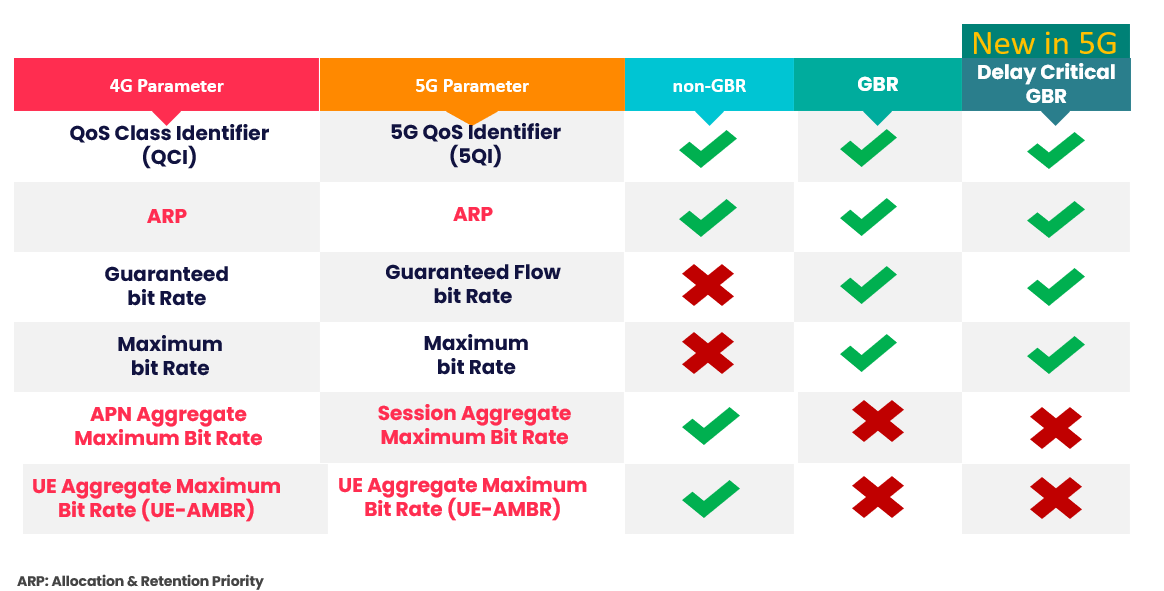
Before going into details let's try to recall our knowledge about Non-GBR, GBR, and delay critical GBR(This is a new concept introduced in 5G).
Non Guaranteed Bit Rate (Non-GBR)
- This type does not provide the end-user a guaranteed flow bit rate(GFBR).
- This type of QoS Flow is typically used for non-time-sensitive applications, e.g., web browsing, buffered streaming, and instant messenger applications.
- Non-GBR QoS Flows are also used to transfer IMS signaling. In this case, it is recognized that the non-GBR QoS Flow is being used for signaling purposes, and the QoS Flow is treated with higher priority.
Guaranteed Bit Rate (GBR)
- This type provides a Guaranteed Flow Bit Rale (GFBR) to the end-user.
- This type of QoS Flow is typically used for time-sensitive applications, e.g. voice and video calls, real-time gaming, V2X
- Simply GBR means, the network can provide and guarantee a minimum/maximum speed for particular services or users.
Delay Critical GBR QoS Flow
- This is a newly introduced concept in 5G.
- This type provides significantly lower latencies than a GBR QoS Flow.
- For example, a GBR QoS Flow may permit a 100 ms delay budget, while a Delay Critical GBR QoS Flow may permit a 10 ms delay budget.
- Delay Critical GBR QoS Flows also have low Packet Error Rates to provide improved reliability.
- Typical applications include automation and intelligent transport systems.
QoS Parameters Explanation
(1) 4G QoS Class Identifier (QCI) and 5G QoS Identifier (5QI)
- In general, QoS Identifiers are used as a pointer to a set of QoS characteristics; for example, in 4G, we used to have different QCIs from 1 to 9, and each of these QCIs has other characteristics; for example, QCI 5 was used for IMS Signaling, QCI 1 for VoLTE and so on.
- While 5G provides almost the same concept as 4G but 5G introduced additional QIs from 82 to 85, which are used for delay critical GBR services, the following figures summarize all QCIs & QIs in 4G & 5G.
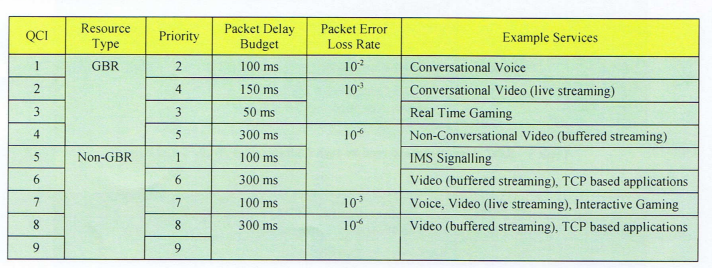
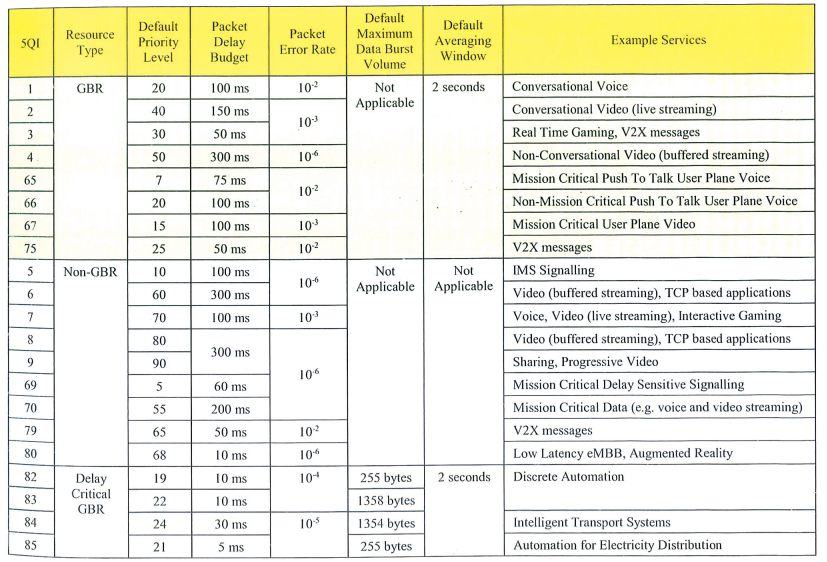
4G & 5G ARP (Allocation & Retention Priority )
- ARP is supported by GBR, Non-GBR, and Delay critical delay GBR, and this is used for something called preemption which we will try to simplify within this section; ARP Supports the following 3 main parameters
- Pre-emption Capability: This means the new connection is allowed to preempt the existing connection
- Pre-emption Vulnerability: This parameter determines whether or not the QoS Flow can be pre-empted by another QoS Flow.
- Priority ( 1 to 15): This parameter can be used to identify which of the existing preemptable QoS Flows should be targeted for pre-emption
- Now let's have a look at the following example, which visualizes the meaning of preemption.
- As shown below, initially Device A has been scheduled with a downlink transmission spanning one slot.
- During the transmission to device A, latency-critical data for device B arrives at the gNB, which immediately schedules transmission to device B.
- Typically, if frequency resources are available, the transmission to device B is scheduled using resources not overlapping with the ongoing transmission to device A.
- However, in the case of a high load in the network, this may not be possible, and there is no choice but to use (some of) the resources originally intended for device A for the latency-critical transmission to device B.
- This is referred to as the transmission to device B preempting the transmission to device A, which obviously will suffer an impact as a consequence of some of the resources device A assumes contains data for it suddenly containing data for device B.
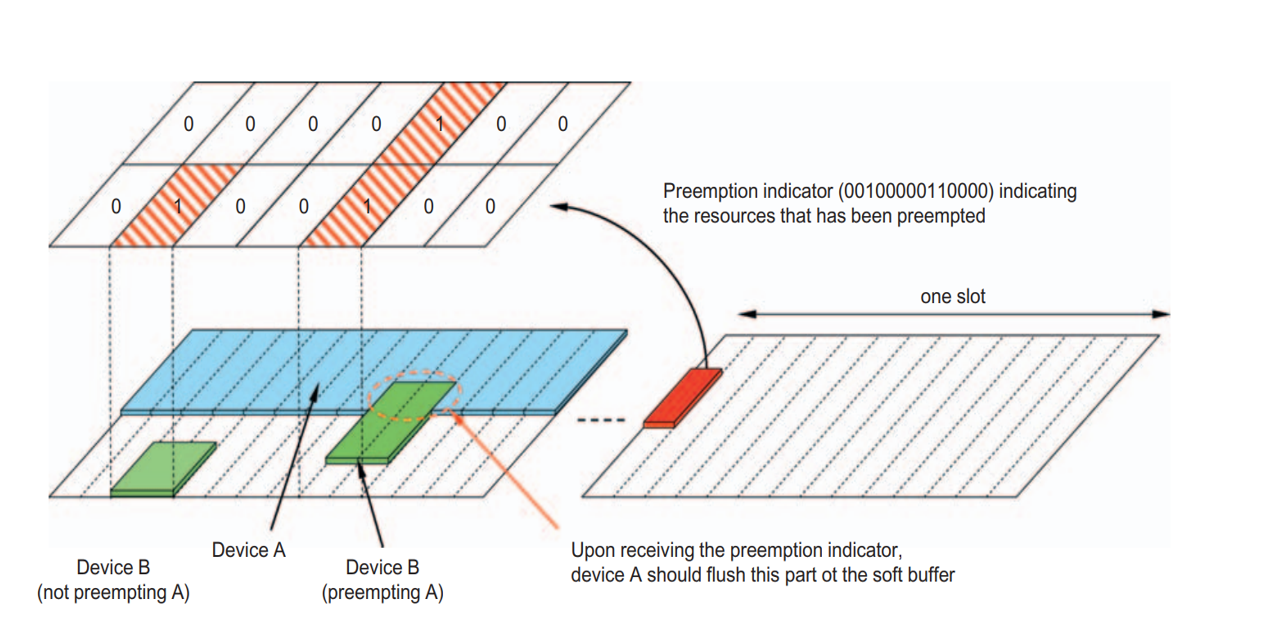
(3) 4G Guaranteed bit Rate and 5G Guaranteed Flow bit Rate
- Simply GBR or GBFR are only applicable for GBR, and it defines the minimum bit rate which can be expected from QoS Flow.
- For example, Operator/Vendor can ensure a minimum speed for some services or users.
(4) 4G & 5G Maximum Bit Rate (MBR/MFBR)
- 4G Maximum Bit Rate (MBR) defines the maximum bit rate which can be expected to be made available to the bearer when required. The MBR can be specified independently for the uplink and downlink.
- 5G Maximum Flow Bit Rate (MFBR) only applies to GBR and Delay Critical GBR QoS Flows.
- It defines the maximum bit rate which can be expected from the QoS Flow when measured across the Averaging Window.
- Packets may be dropped by a throughput shaping function within the Base Station once the MFBR has been achieved.
- The MFBR can be specified independently for the uplink and downlink
(5) 4G & 5G QoS Parameters (UE AMBR Vs. APN AMBR)
Let`s quickly recall the theoretical meaning of both APN/Session AMBR & UE AMBR, and then we will try to simplify with some flow/pictures.
(A) 4G APN & 5G Session
- 4G APN defines the maximum allowed bitrate for a UE based on the sum of all its non-GBR Bearers. Where MME returns APN from HSS.
- 5G Session "Same as APN" define the maximum permitted bit rate summed across all non-GBR QoS Flows belonging to a specific PDU Session. Where SMF returns Session from UDM.
- The following further illustrates the previously mentioned definitions of the 4G APN and 5G Session.
- APN AMBR is falling below P-GW, and P-GW is responsible for enforcing the APN-AMBR; enforcing means any connection or session can’t cross the settings (Speed) applied by P-GW.
- So, in particular scenarios, if P-GW is assigned a low APN, which is matching with the radio/transport capability, this can impact the maximum and even average speed of the users.
- These settings are parameter subscriptions, and it is delivered from
- HSS to PGW in 4G
- UDM to SMF, then to UPF in 5G.
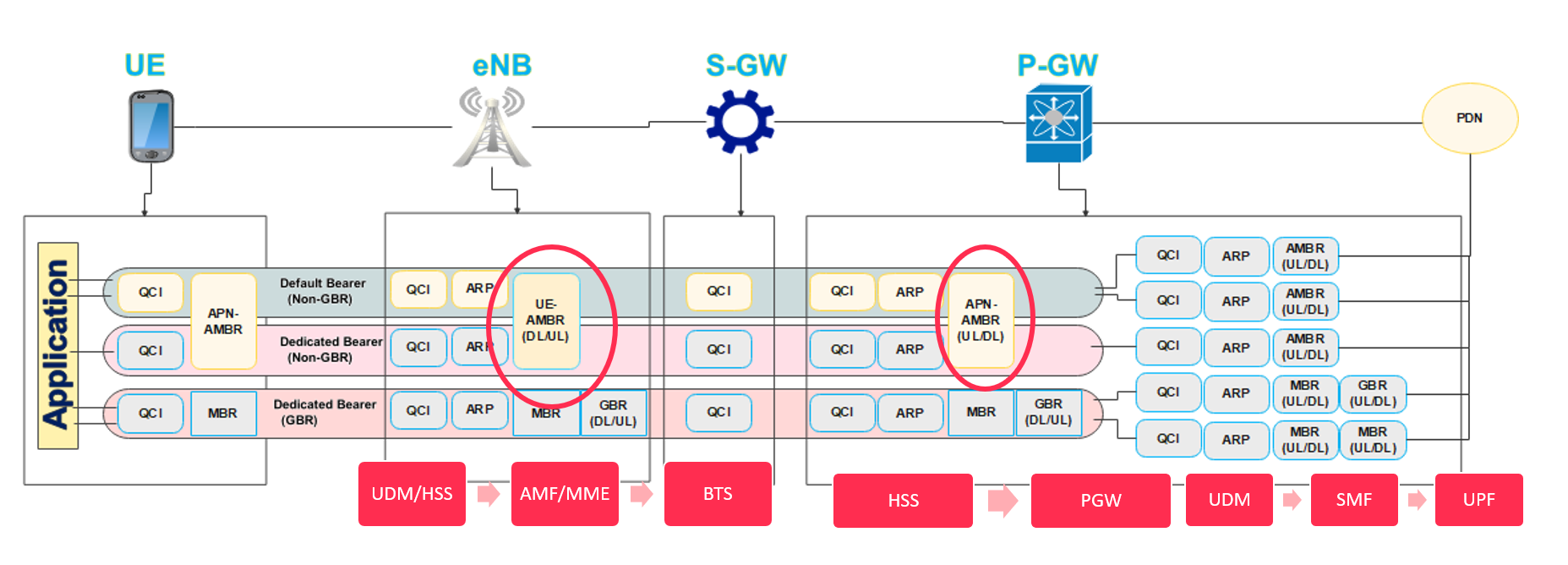
(B) UE AMBR:
- This defines the maximum allowed bit rate summed across all non-GBR QoS Flows belonging to a specific UE, and it is provided to the BTS by AMF/MME through HSS/UDM.
- The following further illustrates UE AMBR:
- The BTS enforces UE AMBR, and The UE AMBR information is not delivered to the UE, so BTS knows the maximum allowed speed for a UE.
- So, for example, if the Users/Radio resources can achieve 200 Mbps but the UE- AMBR allowed is 100 Mbps. IN THIS CASE, the BTS will enforce and only assign resources that cover the maximum allowed UE AMBR, which is 100 Mbps.
- UDM/HSS allocates UE AMBR to AMF/MME and then delivers to the BTS
Now let me further explain the main differences between UE AMBR & APN AMBR. For example, assume that we have two scenarios.
- In Scenario 1, the maximum allowed APN is 200 Mbps, and UE AMBR is 50 Mbps. This means that the UE Maximum speed will be limited to 50 Mbps.
- While for Scenario 2, The UE AMBR is capable of 150 Mbps while APN AMBR is limited to 80 Mbps, the UE Maximum speed will be limited to the maximum speed of the APN AMBR in this case.
- The following formula simplify the below given example

(3) How to check QoS Parameters from Logs
As shown below in the below signaling flow signaling
- UE AMBR can be obtained from Initial Context Setup Request in 4G & 5G.
- While APN AMBR can be obtained from Attach Accept and activate default bearer in 4G and PDU Session Establishment in 5G.
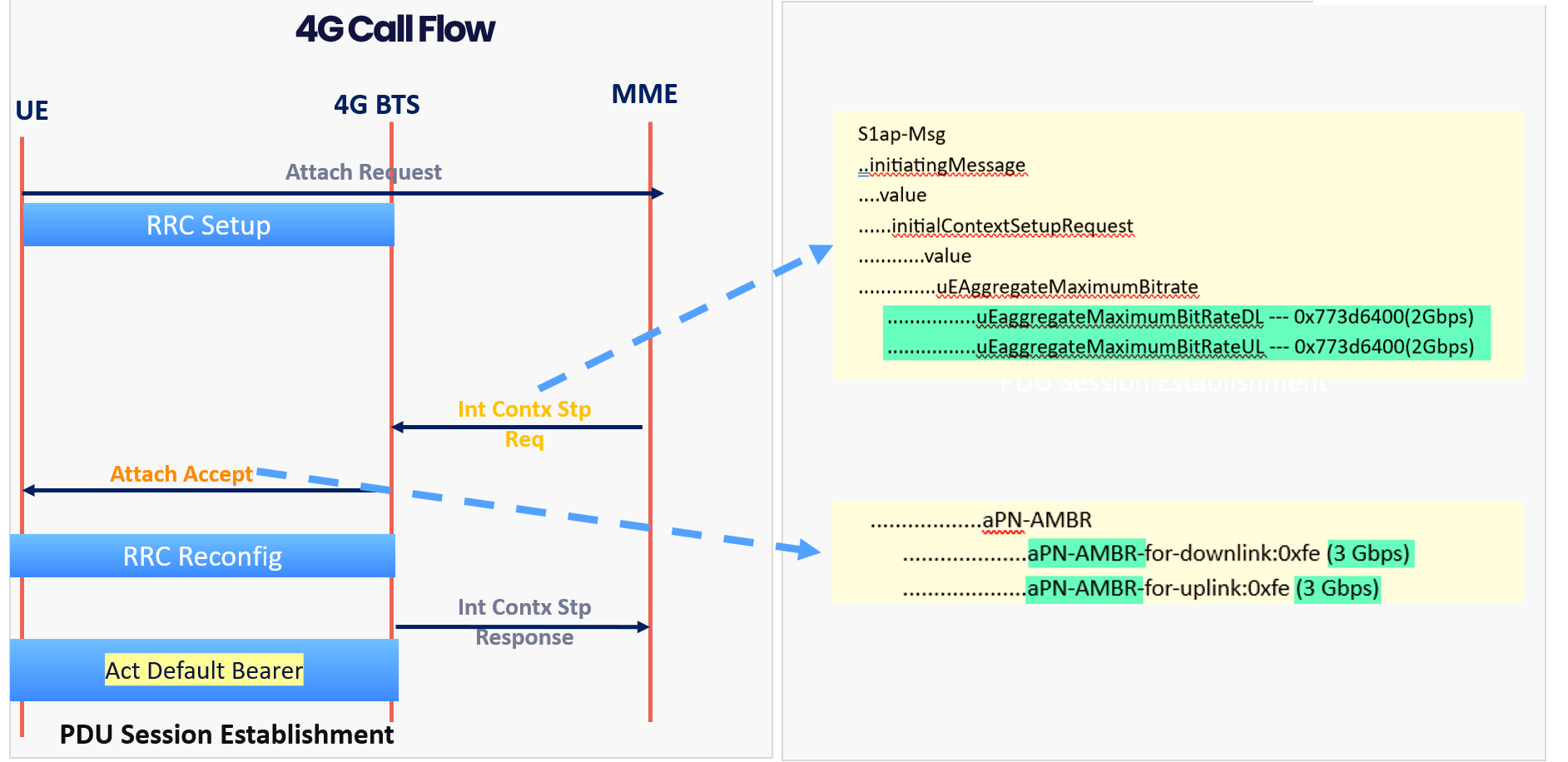
The below video covers the same.
Sources:
- 5G NR in Bullets

